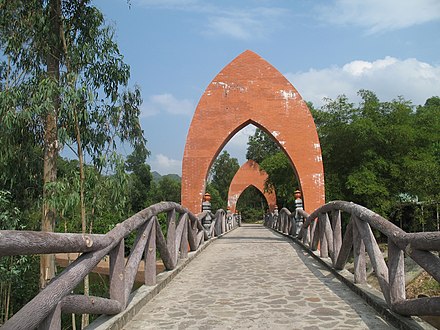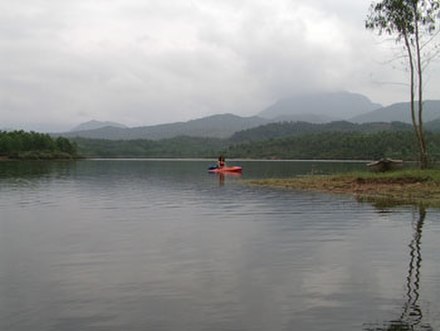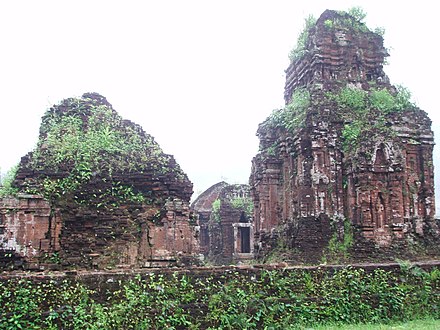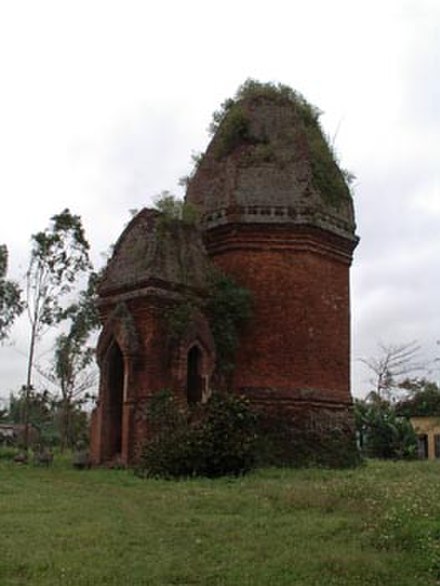My Son - Cluster of abandoned and partially ruined Hindu temples in Vietnam
 My Son (Vietnamese: Mỹ Sơn) is a set of ruins from the ancient Cham Empire in the central coast of Vietnam. It is a UNESCO World Heritage Site.
My Son (Vietnamese: Mỹ Sơn) is a set of ruins from the ancient Cham Empire in the central coast of Vietnam. It is a UNESCO World Heritage Site.
Understand
My Son was built by the Champas who ruled Central Vietnam from c.200-c.1700 CE until annexed by the Vietnamese in the 19th century. Influenced by Hinduism, the Champas built temple complexes in Central Vietnam. The best-known and preserved temple still in daily use by Buddhists is the Po Nagar Cham Tower in Nha Trang. The temples of My Son were the most important temples of the Champa Kingdom. Bricks were used to build the temples, without mortar, and sculptures of gods, priests, animals, and scenes of mythical battles and devotion adorned the walls. These temples were places of worship of Lord Vishnu.
After the fall of the Champa, the jungle began to reclaim the area. The temples had already fallen into disrepair by the 1960s, when the Viet Cong used My Son as a base. An act of the U.S. Congress prohibited bombing of My Son during the war, but nevertheless the site suffered devastating bombing raids by the United States Air Force
My Son was designated a UNESCO World Heritage Site in 1999. There are travel guides that compare My Son with Angkor, Bagan and Borobudur. Historically, they have a point: in their time, these complexes were leading spiritual centres, and they have all fallen into a state of ruin. However, the ruins at My Son are far less impressive than any of the other sites, for various reasons: the smaller scale of the original site, for example, the comparatively poor upkeep and the severe damage to the buildings from time and war. Even so, this is a unique and important historical site, and the gorgeous jungle scenery alone may be worth the trip.
The best time of the day to visit My Son is early in the morning or late in the afternoon when there are few tourists.
Get in
My Son, being a UNESCO site, has a flat admission charge of 150,000 dong per person (December 2022), payable at the ticket office near the entrance, and applies regardless of how you get there.
To travel 43 km from Hoi An to My Son you have several options:
- Take a motorbike taxi. A round-trip on a motorbike taxi from the centre of Hoi An should cost about USD 10.
- Hire a motorbike and drive yourself. Motorbike hire should cost about USD 4-5 for the day, which gets you the bike and about enough fuel to reach the nearest filling station. As it is only a 43 km drive, you will need around 2 litres of petrol, which costs about 42,000 dong.
Directions: from Hoi An take Hung Vuong St and keep following it towards the town of Vinh Dien for about 7 km until you pass under a highway. Take the first left in the curve and go straight for about a km till you reach the T-junction on Rte 1 (or 1A), turn left towards the south. Drive for 7 km to Nam Phuoc. In the town, you'll see a big sign for My Son posted on a lamp post. Turn right there. From there, keep following the signs for 30 km until you reach the entrance for My Son. There is covered motorbike parking (10,000 dong) before the entry ticket purchase and check stations.
- Car hire with driver. A car hire will cost USD 25 to 35 from Hoi An (2022) and about USD 70 from Da Nang. Both prices include return trips and the driver's waiting time, by My Son admission is extra.
- Take a boat. The caveat being that the "My Son Boat Tour" goes no further than about 10 km north of Hoi An and stops at the Rte 1 bridge, which is still about 40 km from My Son.
- Join a tour group. These leave Hoi An at 05:00 and 08:00. These are cheap, USD 3-5, not including the My Son entrance fee. The reason the tours are cheap is that they stop at restaurants and businesses allied with the tour operator. They are also inefficient. While the "tour" lasts about 6 hr, only about 1 hr of that will be at the site of the ruins. The rest will be spent waiting for others to join the tour or visiting dodgy businesses.
Get around
All vehicles will stop at a designated car park near the entrance and ticket office. After entering and crossing a bridge, you will find a designated station (that doubles up as a depot) where you can take an electric bus to the ruins free of charge; however for the sake of convenience, some electric bus drivers may drive onto the bridge itself to pick up passengers. The distance between the bridge and the site of the ruins is around 2 km, and while it's an easy uphill walk you might be better off taking the bus if you are pressed for time or if it is very hot.
You can explore the ruins by foot, with nothing more challenging than a slight hill to negotiate. Maps of the area tend to give the impression that the site is larger than it actually is. There are plenty of comfortable, rustic-looking benches along the way.
See & do



Near the ticket office there is a Champa Museum, describing many of the artifacts and the history of the site. The curators have made the odd (and maddening) decision to remove virtually all of the better-preserved sculptures from the ruins and display them here or at the small museum in Group A instead of in context with the temples where they belonged. Accordingly, try to visit the museum briefly before visiting the temples themselves. It closes a half-hour before everything else, so you might not be able to catch it on the way out.
The temples are in varying states of disrepair, with restoration still underway on some. There are nine "groups", labeled A-G. Effectively, there are three major sites: A, B-C-D, and E-F. The G, H and L ruins are separate and a little trickier to find. If you can't find them, don't spend all day trying; they're much smaller than the rest. All of the sites are connected by reasonably well-labelled walking tracks.
The layout of the temples is dictated by the rays of the sun and in the early morning this is clearly evident. The early morning sunlight shines behind the head of Lord Vishnu from where it is scattered throughout.
There are traditional dancing displays at 09:45 (daily except Mondays) for the benefit of tour groups. The stage is before you reach the first group of ruins, across from the souvenir shop.

- If you enjoyed My Son and want to see a good example of a Champa Tower in the Hoi An area then go to the nearby village of Vinh Dinh and on the road north (alongside the Vu Gia river). You will find there a very well-preserved relic, the "Bang An Tower". This is hardly ever seen by tourists and is still in use by worshippers.
- Just past Tra Kieu heading towards My Son on the left is the small but excellent Sa Huynh Museum which includes some artefacts from Cham (free of charge). Building shape is more Cham than Vietnamese. Many of the artefacts were donated by a Catholic priest who lived in Tra Kieu.
- The streams running through My Son end up in a still lake about 3 km long which is ideal for kayaking. Hardly anyone knows about or uses this unspoiled gem. Karma Waters operates kayaking trips on My Son Lake.
Buy
There is a souvenir shop within the site. It sells generic Vietnam souvenirs and also a selection of items influenced by Champa culture.
Eat & drink
Numerous roadside cafes and restaurants line the road from Hoi An to My Son. Tour buses never stop at them because drivers, guides, and tour operators do not earn "commissions" at these places.
The first open-air restaurant on the left coming into My Son is owned by a local family. Mr Duong has lived in My Son since 1995, when My Son village was created by the Vietnamese Government and funded by Italy in anticipation of UNESCO WHS status. Duong provides good food, drinks, rest (hammocks), and parking. Prices a little high but reasonable for My Son.
Next door to Duong and about 100 m away from the My Son entrance is the Ganesa Restaurant, which sounds Indian but is a Vietnamese restaurant. Check out the high prices and low quality. Note some tour companies like Camel Open Tour, Anh Phu and others stop at this restaurant.
Sleep
There is no accommodation in My Son. The nearest hotel is about 2 km down the road from the ticket office. Most visitors visit My Son as a day-trip from Hoi An, Da Nang, or even Hue.
There are a few guest houses close by where accommodation may also be available.
Stay safe
Don't wander too far from the clearly-marked walking tracks between the sites. Although authorities say that the area has been cleared of unexploded ordnance, you're a long way from help in case of an accident.
Go next
Mỹ Sơn
Date Time:Please wait...Timezone:Asia/Ho_Chi_MinhCoordinates:15.77, 108.12